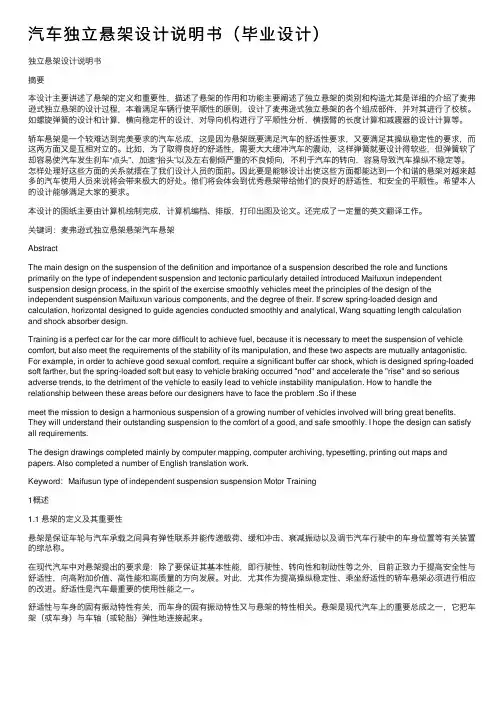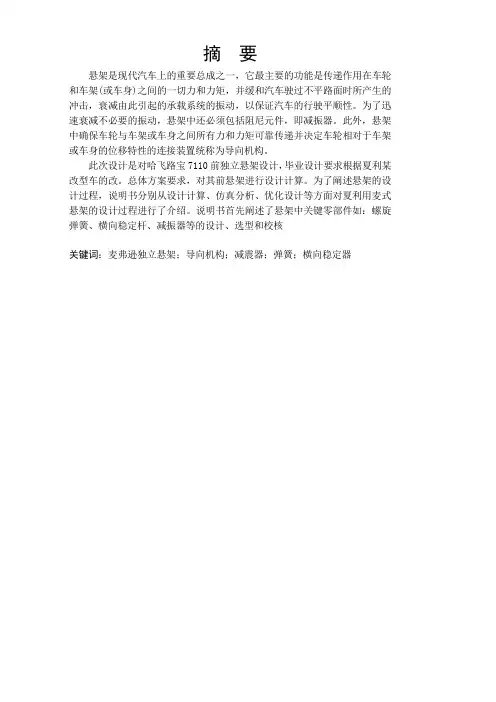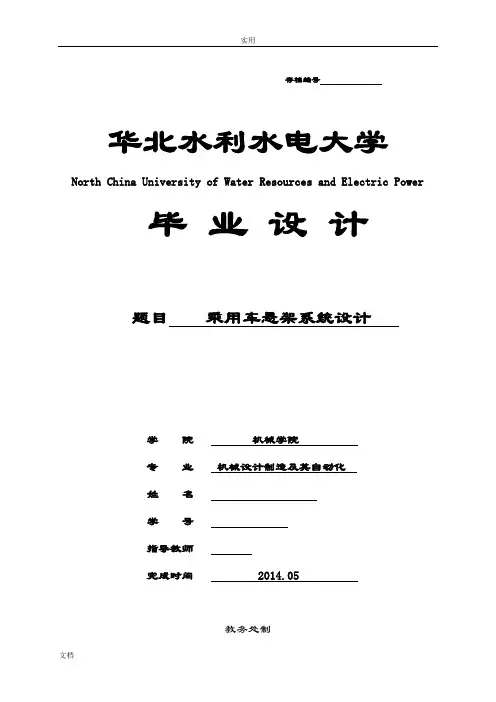麦弗逊悬架的毕业设计
汽车独立悬架设计说明书(毕业设计)

汽车独⽴悬架设计说明书(毕业设计)独⽴悬架设计说明书摘要本设计主要讲述了悬架的定义和重要性,描述了悬架的作⽤和功能主要阐述了独⽴悬架的类别和构造尤其是详细的介绍了麦弗逊式独⽴悬架的设计过程,本着满⾜车辆⾏使平顺性的原则,设计了麦弗逊式独⽴悬架的各个组成部件,并对其进⾏了校核。
如螺旋弹簧的设计和计算,横向稳定杆的设计,对导向机构进⾏了平顺性分析,横摆臂的长度计算和减震器的设计计算等。
轿车悬架是⼀个较难达到完美要求的汽车总成,这是因为悬架既要满⾜汽车的舒适性要求,⼜要满⾜其操纵稳定性的要求,⽽这两⽅⾯⼜是互相对⽴的。
⽐如,为了取得良好的舒适性,需要⼤⼤缓冲汽车的震动,这样弹簧就要设计得软些,但弹簧软了却容易使汽车发⽣刹车“点头”、加速“抬头”以及左右侧倾严重的不良倾向,不利于汽车的转向,容易导致汽车操纵不稳定等。
怎样处理好这些⽅⾯的关系就摆在了我们设计⼈员的⾯前。
因此要是能够设计出使这些⽅⾯都能达到⼀个和谐的悬架对越来越多的汽车使⽤⼈员来说将会带来极⼤的好处。
他们将会体会到优秀悬架带给他们的良好的舒适性,和安全的平顺性。
希望本⼈的设计能够满⾜⼤家的要求。
本设计的图纸主要由计算机绘制完成,计算机编档、排版,打印出图及论⽂。
还完成了⼀定量的英⽂翻译⼯作。
关键词:麦弗逊式独⽴悬架悬架汽车悬架AbstractThe main design on the suspension of the definition and importance of a suspension described the role and functions primarily on the type of independent suspension and tectonic particularly detailed introduced Maifuxun independent suspension design process, in the spirit of the exercise smoothly vehicles meet the principles of the design of the independent suspension Maifuxun various components, and the degree of their. If screw spring-loaded design and calculation, horizontal designed to guide agencies conducted smoothly and analytical, Wang squatting length calculation and shock absorber design.Training is a perfect car for the car more difficult to achieve fuel, because it is necessary to meet the suspension of vehicle comfort, but also meet the requirements of the stability of its manipulation, and these two aspects are mutually antagonistic. For example, in order to achieve good sexual comfort, require a significant buffer car shock, which is designed spring-loaded soft farther, but the spring-loaded soft but easy to vehicle braking occurred "nod" and accelerate the "rise" and so serious adverse trends, to the detriment of the vehicle to easily lead to vehicle instability manipulation. How to handle the relationship between these areas before our designers have to face the problem .So if thesemeet the mission to design a harmonious suspension of a growing number of vehicles involved will bring great benefits. They will understand their outstanding suspension to the comfort of a good, and safe smoothly. I hope the design can satisfy all requirements.The design drawings completed mainly by computer mapping, computer archiving, typesetting, printing out maps and papers. Also completed a number of English translation work.Keyword:Maifusun type of independent suspension suspension Motor Training1概述1.1 悬架的定义及其重要性悬架是保证车轮与汽车承载之间具有弹性联系并能传递载荷、缓和冲击、衰减振动以及调节汽车⾏驶中的车⾝位置等有关装置的综总称。
轿车前麦弗逊悬架毕业设计

毕业披廿(论文)奇瑞轿车前麦弗逊悬架设廿可修编・X 11Abstract21绪论31.1课题背景和意义 (3)1.2悬架的发展历史和现状 (4)1.3悬架的发展體势 (5)1.4课题主要容和研究目的 (5)2悬架结构方案分林62.1悬架总成分析 (6)2.2独立悬架优缺点分析 (6)2.3独立悬架特点与分类 (7)2.3.1双横臂式悬架构造及其特征分析 (7)2.3.2单横臂式悬架构造及其特征分析 (7)2.3.3单斜臂式悬架构造及其特征分析 (9)2.3.4麦弗逊式悬架构造及其特征分析 (10)3麦弗遜戏数立悬架atm3.1麦弗逊式独立悬架设计ffliS 113.3麦弗逊悬架的结构分林 (12)3.4悬架的耶性特性设计 (13)3.5悬架挠度£的设计 (13)3.5.1悬架静挠度£的设计 (13)3.5.2悬架动挠度办设计 (14)3.6悬架呷性元件设计 (14)3.6.1螺旋耶簧分林 (14)3.6.2螺旋耶簧地质料及许用应力选取 (15)3.6.3弹簧参数的计算选择 (15)3.6.4计算空载M度 (16)3.6.5计算满载M度 (16)3.6.6按照満载运算弹簧拥丝的直径 (16)3.6.7螺旋耶簧校核 (17)3.6.8 小结 (17)3.7导向机构设计 (18)3.7.1导向机构地设计要求 (18)3.7.2导向机构的布置参数 (19)3.7.3导向机构的受力分林 (22)3.7.4横臂轴线安81方法地选取 (22)3.7.5横瞿臂参数对车轮定位参数地改变 (23)3.7.6导向机构建模 (24)3.8减振器的设计 (24)3.8.1城振器的简单分类 (24)3.8.2双向筒贰液力械振器工作原理 (25)3.8.3相对阻力系数屮 (25)3.8.4城振器阻尼系数6地确定 (26)3.8.5城振器工作缸直径D地确定 (26)3.8.6 小结 (27)3.9横向稳定器 (28)3.10悬架結构元件 (29)4甫轮定位参数304.1主舗后頓角 (30)4.2主细蹶角 (31)4.3前轮外倾角 (33)4.4前轮前束 (34)结東培35辞36参考文It 37ft要悬架为当今汽车组成必不可少得一部分,他完成让车身与轮胎有效的術接地作用。
前麦弗逊悬架和后多连杆悬架设计定稿版

前麦弗逊悬架和后多连杆悬架设计精编W O R D版IBM system office room 【A0816H-A0912AAAHH-GX8Q8-GNTHHJ8】存档编号华北水利水电大学North China University of Water Resources and Electric Power毕业设计题目乘用车悬架系统设计学院机械学院专业机械设计制造及其自动化姓名学号指导教师完成时间 2014.05教务处制独立完成与诚信声明本人郑重声明:所提交的毕业设计(论文)是本人在指导教师的指导下,独立工作所取得的成果并撰写完成的,郑重确认没有剽窃、抄袭等违反学术道德、学术规范的侵权行为。
文中除已经标注引用的内容外,不包含其他人或集体已经发表或撰写过的研究成果。
对本文的研究做出重要贡献的个人和集体,均已在文中作了明确的说明并表示了谢意。
本人完全意识到本声明的法律后果由本人承担。
毕业设计(论文)作者签名:指导导师签名:签字日期:签字日期:毕业设计(论文)版权使用授权书本人完全了解华北水利水电大学有关保管、使用毕业设计(论文)的规定。
特授权华北水利水电大学可以将毕业设计(论文)的全部或部分内容公开和编入有关数据库提供检索,并采用影印、缩印或扫描等复制手段复制、保存、汇编以供查阅和借阅。
同意学校向国家有关部门或机构送交毕业设计(论文)原件或复印件和电子文档(涉密的成果在解密后应遵守此规定)。
毕业设计(论文)作者签名:导师签名:签字日期:签字日期:摘要悬架的主要功能是传递作用在车轮和车身之间的一切力和力矩,缓冲传给车身的冲击载荷,通过减震器衰减由车轮引起的簧上震动,保证汽车行驶的平顺性,保证车轮在路面不平和载荷变化时有理想的运动特征,增强汽车的操纵稳定性,轻便性。
本文首先论述了悬架的分类、优缺点及国内外的研究现状,然后以日产天籁为设计参照,使用传统设计方法(非优化设计)设计计算前麦弗逊悬架和后多连杆悬架,涵盖了选定悬架质量分配系数,选定车震频率、偏频比,计算悬架静挠度和动挠度,减震器行程及工作缸内径的选择及螺旋弹簧的直径、工作圈数设计等。
轿车悬架设计—麦弗逊独立悬架文献综述

广西科技大学(筹)毕业设计(论文)附录资料课题名称轿车悬架设计—麦弗逊独立悬架学院汽车与交通学院专业交通运输(汽车电子技术与检测诊断)班级交Y091学号 200900207042姓名周文江指导教师陈坤2013年 1月 6 日目录一、英文原文 (3)二、中文翻译 (9)三、方案论证 (14)一、英文翻译Survey of Controllable Suspension System for Off-road Vehicles Abstract:The controllable suspension system can improve the performances of off-road vehicles both on road and cross- country.So far,four controllable suspensions,that is,body height control,active,semi-active and slow-active suspensions,have been developed.For off-road vehicles,the slow-active suspension and the semi-active suspension which have controllable stiffness,damping and body height are more appropriate to use.For many years,some control methodologies for controllable suspension systems have been developed along with the development of modern control theory,and two or more original control method s are integrated as a new control method .Today,for military or civilian off-road vehicles,the R& D of controllable suspension systems is ongoing.Key Words:control theory;survey;controllable suspension;off-road vehicleThe suspension system is an important part of the vehicle,which influences riding comfort and handle-stability greatly.Since the first pair of leaf spring was used in carriage,suspension systems were uncontrollable for a long time and named as passive suspension system.A typical passive suspension system consists of springs,dampers and some control arms,which are once invariable designed.But,the roads for vehicle running are various.For the vehicle’s suspension system,different kinds of roads make different inputs.Thus ,different suspension parameters,such as stiffness,damping and body height,should be designed to minimize the impact from ground and the jounce of body.However,it’s impossible that the traditional vehicles with in variable passive suspension system perform well on multifarious roads.For off-road vehicles,the conflict between changeful roads and changeless suspensions is more projecting than road vehicles.Most of off-road vehicles are still using the passive suspension systems and have higher stiffness,damping and body height to overcome the rough road or cross-country.However,these vehicles show worse riding comfort and handle stability than road vehicles on normal roads.For these reasons,the controllable suspension systems should be the best choice for vehicles,especially for the off-road vehicles.1 Categories of Controllable Suspension SystemThe controllable suspension system is a general reference of the non-passive suspension system,the antonym of passive suspension should be active suspension But,in the suspension control,the active suspension is a special type of controllable suspensions.Today,the controllable suspensions can be divided into four categories according to the controlled objects and structures.They are body height control,active,semi-active and slow-active suspensions.The quarter-vehicle vibration models of these different controllable suspension systems are shown inFig.1.1.1 Body Height Control Suspension SystemThe body height control suspension system is the pioneer of controllable suspension systems.The first body height control suspension system was used in CitrOen DS19 launched in 1955 and made in France.It adopts four controllable air springs and can adjust obviously that the active suspension system improves the body height according to run condition and load to guarantee proper wheel travels[1] .This kind of system is the simplest controllable suspension system,usually found in luxurious buses and pickup trucks.A bus equipped with this system can keep the body height unchanging whether it is empty or full.The body height control suspensions are also designed for the pickup truck’s real suspensions,it can keep the body horizontal,whether it links a trailer or not.The main structural difference between the body height control suspension and the passive suspension is that the former has a height control system additionally,which includes body height sensors,height drives and a controller,as shown in Fig.1(a).It aims at controlling the body height only,though the suspension’s stiffness and damping also change in the control process.The inputs mainly include the speed of vehicle and the distance between body and wheel,which are collected by speed and displacement sensors.The proper body height data shall be calculated based on a certain control strategy by the body height control system and output to the executing mechanism.1.2 Active Suspension SystemThe concept of active suspension was presented early in 1954[2].Thompson,in 1960’s,consummated its basic structure and control law and proved that so-called ful1-active suspension system could improve the performances of vehicle effectively.Since 1980’s,the research achievements on active suspension had been put into use. Some testing vehicles were built[3]. The experiment for these vehicles showed obviously that the active suspension system improves vehicle's performance greatly.The active suspension system consists of sensors,controllers and force actuators,as shown in Fig.1(b)[4]. And,for driving force actuators,an additional power is necessary.It adopts the force actuator to replace the customary spring and absorber.The forceactuators can be controlled to produce appropriate forces to support the body,whenever the vehicle runs in any road.The body and wheel sensors are used to measure the accelerations of the body and wheel and provide these data to the controller.The latter processes these data and outputs some instructions to the force actuator according to predefined control strategy which determines the quality of the active suspension system.Although the active suspension system has been presented for more than fifty years,it hasn’t been largely commercialized yet up to now.Of course,the technical and economic reasons coexist.In technology,today’s active suspension systems can work well in low frequency band but not in high frequency,since the force actuators seems too stiff to control[5].Although some active suspension systems can operate well up to 70 Hz[6],they will consume energy very much[7].One of the methods to reduce the power consumption uses springs and dampers in parallel with the actuators.In addition,it also improves the security of the active suspension system.But,as a negative result,the system response will be decreased.In economy,building and operating an active suspension system costs too much.It fatally limits the active suspension systems to be extended.1.3 Semi-active Suspension SystemThe semi-active suspension system was presented later but applied earlier to the vehicles than active suspension system.The controllable suspension system with adjustable stiffness and damping was introduced in early 1970’s.It almost does not consume energy,since the force actuators which need too much energy are eliminated.So,it is called as semiactive or no power active suspension system.The common semiactive suspension systems only control the damping of suspension actively,and some senior semiactive suspension systems also control the stiffness.In fact,a semi-active suspension system is just a passive suspension system with controllable damping and stiffness,as shown in Fig.1 (c).So ,its performances are still not as good as the active suspension system.A famous control model of the semiactive suspension system was so-called Sky-Hook Damping Control proposed by Karnopp in 1973[8].In this model,a supposed inertial damper,called as Sky-Hook damper,is set between a sprung mass and a virtual fixed Sky-Hook.The force of the Sky-Hook damper proportional to the relative speed of the sprung mass to the Sky-Hook can reduce the jounce of the vehicles.For the Sky-Hook and Sky-Hook damper are both inexistence in real vehicles,an controlled adjustable damper is set to replace the passive damper between the sprung mass and unsprung mass in real Sky-Hook model.Theoretically,the damping force should change continuously and in real-time[9],but it is usually hard to be done in real vehicles.A control model for the semi-active suspension systems with discrete adjustable damping and stiffness was proposed by Margolis in 1975[10].Several dampers or springs are paralleled,thus,if one or more of them are shut off,the damping or stiffness of the suspension system will change discretely.For it is easy to achieve,the Margolis model have been used in so me cars.Some semi-active suspension systems are even added the body height control to improve the vehicle performances.This controllable height semi-active suspension system has been used in some luxurious car and SUV recently.Some of them are named as the active suspension by their manufacturer,but they are still different from the real active suspension.1.4 Slow-active Suspension SystemThe slow-active suspension system is presented later but more remarkably.Its essential structure can be regarded as a series of an active suspension system and a passive suspension system,as shown in Fig.1 (d).As the passive suspension system can isolates high-frequency vibration well,the active suspension system can only isolate low-frequency vibration.The force actuators only work in the low-frequency band,power consumption are reduce evidently.Theoretically,the slow-active suspension system still responds more slowly than the real active suspension system,this is the reason why it is so named[11].Some other names,such as narrow bandwidth active suspension system or limited bandwidth suspension system,are also found.By contrast,the real active suspension system is usually called as full-active suspension system or broad bandwidth active suspension system[12].To improve performances of the slow-active suspension system,the springs and dampers in the system should be controllable.This slow-active suspension system can be regarded as a series of an active suspension and a semi-active suspension.As an unavoidable result,the control system and mechanical structure are more complex.The performances of the slow-active suspension system are almost as goo d as the full-active suspension system,and the power consumption is fairly less.Its prospect will be very wel1.2 Control Methodologies for Controllable Suspension SystemsThe control theories for controllable suspension systems grow along with the development of modem control theory.Recently,the typical control strategies include LQG (linear-quadratic-Gaussian)optimal control,model reference adaptive/self-tuning control,preview control,fuzzy control,neural network control,etc.2.1 LQG Optimal Control Strategy LQGFor the linear vibration model of the active suspension systems,the control attempts to minimize the integrated weight of body vertical acceleration,wheel dynamic load and wheel dynamic travel.The objective function of the control system is quadratic.And the disturbance input from road is a stochastic process that can be deal with as a Gaussian white noise.Thus,the suspension control problem can be regarded as a typical LQG optimal control[13].According to LQG optimal control strategy,the optimal control force Uo can be defined aU。
前麦弗逊独立悬架毕业设计

摘要悬架是现代汽车上的重要总成之一,它最主要的功能是传递作用在车轮和车架(或车身)之间的一切力和力矩,并缓和汽车驶过不平路面时所产生的冲击,衰减由此引起的承载系统的振动,以保证汽车的行驶平顺性。
为了迅速衰减不必要的振动,悬架中还必须包括阻尼元件,即减振器。
此外,悬架中确保车轮与车架或车身之间所有力和力矩可靠传递并决定车轮相对于车架或车身的位移特性的连接装置统称为导向机构。
此次设计是对哈飞路宝7110前独立悬架设计,毕业设计要求根据夏利某改型车的改。
总体方案要求,对其前悬架进行设计计算。
为了阐述悬架的设计过程,说明书分别从设计计算、仿真分析、优化设计等方面对夏利用麦式悬架的设计过程进行了介绍。
说明书首先阐述了悬架中关键零部件如:螺旋弹簧、横向稳定杆、减振器等的设计、选型和校核关键词:麦弗逊独立悬架;导向机构;减震器;弹簧;横向稳定器ABSTRACTSuspension is the modern car on the important assembly, which has one of the main function is to transfer function in the wheels and frame (or body) all between the force and moment, and ease when rough road surface cars driving by the impact of attenuation arising from the vibration of the bearing system, to ensure the smooth running of the car. So must the wheel and frame or body to provide flexible connection between, rely on the elastic element to deliver the wheel or axle and frame or between vertical load of the body, and depend on the deformation to absorb energy, to achieve the purpose of the buffer.This design is to LuBao hafei before 7110 independent suspension design, the graduation design requirements according to a car to retrofit of the entrant 。
前麦弗逊悬架和后多连杆悬架设计

存档编号华北水利水电大学North China University of Water Resources and Electric Power 毕业设计题目乘用车悬架系统设计学院机械学院专业机械设计制造及其自动化姓名学号指导教师完成时间 2014.05教务处制独立完成与诚信声明本人郑重声明:所提交的毕业设计(论文)是本人在指导教师的指导下,独立工作所取得的成果并撰写完成的,郑重确认没有剽窃、抄袭等违反学术道德、学术规范的侵权行为。
文中除已经标注引用的内容外,不包含其他人或集体已经发表或撰写过的研究成果。
对本文的研究做出重要贡献的个人和集体,均已在文中作了明确的说明并表示了谢意。
本人完全意识到本声明的法律后果由本人承担。
毕业设计(论文)作者签名:指导导师签名:签字日期:签字日期:毕业设计(论文)版权使用授权书本人完全了解华北水利水电大学有关保管、使用毕业设计(论文)的规定。
特授权华北水利水电大学可以将毕业设计(论文)的全部或部分内容公开和编入有关数据库提供检索,并采用影印、缩印或扫描等复制手段复制、保存、汇编以供查阅和借阅。
同意学校向国家有关部门或机构送交毕业设计(论文)原件或复印件和电子文档(涉密的成果在解密后应遵守此规定)。
毕业设计(论文)作者签名:导师签名:签字日期:签字日期:摘要悬架的主要功能是传递作用在车轮和车身之间的一切力和力矩,缓冲传给车身的冲击载荷,通过减震器衰减由车轮引起的簧上震动,保证汽车行驶的平顺性,保证车轮在路面不平和载荷变化时有理想的运动特征,增强汽车的操纵稳定性,轻便性。
本文首先论述了悬架的分类、优缺点及国内外的研究现状,然后以日产天籁为设计参照,使用传统设计方法(非优化设计)设计计算前麦弗逊悬架和后多连杆悬架,涵盖了选定悬架质量分配系数,选定车震频率、偏频比,计算悬架静挠度和动挠度,减震器行程及工作缸内径的选择及螺旋弹簧的直径、工作圈数设计等。
本次设计中使用UG软件做出三维模型,再进行装配,装配完成后,将其分别导入ADAMS/car和adams/view中进行仿真分析和动画仿真,得出汽车行驶时的仿真动画、整车车轮前束角、整车车轮外倾角、前轮主销内倾角、前轮主销后倾角、摩擦半径、后轮侧倾中心坐标的相关数据变化。
麦弗逊悬架毕业设计
毕业设计(论文) 奇瑞轿车前麦弗逊悬架设计系别:机械与电子工程系专业(班级):机械设计制造及其自动化2班作者(学号):指导教师:业红玲(讲师)完成日期: 2008年11月11日蚌埠学院教务处制目录摘要 (1)Abstract (2)1 绪论 (3)课题背景和意义 (3)悬架的发展历史和现状 (4)悬架的发展趋势 (5)课题主要内容和研究目的 (5)2 悬架结构方案分析 (5)悬架总成分析 (5)独立悬架优缺点分析 (6)独立悬架特点与分类 (6)双横臂式悬架构造及其特征分析 (7)单横臂式悬架构造及其特征分析 (7)单斜臂式悬架构造及其特征分析 (8)麦弗逊式悬架构造及其特征分析 (9)3 麦弗逊式独立悬架设计 (10)麦弗逊式独立悬架设计概述 (10)麦弗逊悬架的结构分析 (12)悬架的弹性特性设计 (12)悬架挠度f的设计 (13)c悬架静挠度f的设计 (13)c悬架动挠度f设计 (14)d悬架弹性元件设计 (14)螺旋弹簧分析 (14)螺旋弹簧地质料及许用应力选取 (15)弹簧参数的计算选择 (15)计算空载刚度 (16)计算满载刚度 (16)按照满载运算弹簧钢丝的直径 (16)螺旋弹簧校核 (16)小结 (17)导向机构设计 (18)导向机构地设计要求 (18)导向机构的布置参数 (19)导向机构的受力分析 (22)横臂轴线安放方法地选取 (22)横摆臂参数对车轮定位参数地改变 (23)导向机构建模 (24)减振器的设计 (24)减振器的简单分类 (24)双向筒式液力减振器工作原理 (24)相对阻力系数ψ (25)减振器阻尼系数δ地确定 (25)减振器工作缸直径D 地确定 (26)小结 (27)横向稳定器 (27)悬架结构元件 (28)4 前轮定位参数 (30)主销后倾角 (30)主销内倾角 (31)前轮外倾角 (32)前轮前束 (33)结束语 (35)谢辞 (36)参考文献 (37)摘要悬架为当今汽车组成必不可少得一部分,他完成让车身与轮胎有效的衔接地作用。
前麦弗逊悬架和后多连杆悬架设计毕业论文
前麦弗逊悬架和后多连杆悬架设计毕业论文目录摘要...................................................... 错误!未定义书签。
Abstract .................................................. 错误!未定义书签。
第一章绪论 (1)1.1课设背景及研究意义 (1)1.2国外的研究现状 (1)1.3本文的主要研究容 (3)第二章悬架的结构分析与整体参数设计 (3)2.1悬架系统的简介与分类 (4)2.1.1悬架系统的简介 (4)2.1.2悬架系统的分类 (5)2.2独立悬架的特点 (5)2.3整体参数的设计 (6)2.3.1主要技术指标或主要参数 (6)2.3.2频率的选取与计算 (7)2.3.3悬架系统的静挠度 (7)2.3.4悬架系统的动挠度 (8)2.3.5悬架系统刚度 (8)第三章悬架系统的设计计算 (9)3.1悬架设计的一般要求 (10)3.2减振器选择 (10)3.2.1减震器工作原理 (10)3.2.2阻尼系数的确定 (11)3.2.3最大卸载力 (13)3.2.4减振器的尺寸设计 (14)3.3螺旋弹簧的设计计算 (17)3.4横向稳定杆设计 (21)3.5悬架系统的杆系设计 (24)第四章悬架的三维建模 (25)4.1麦弗逊前悬架的三维建模 (25)4.2后多连杆悬架的三维建模 (28)4.3整车悬架装配图 (31)第五章悬架系统的运动学仿真 (33)5.1基于adams/view的运动仿真 (33)5.2基于adams/car的仿真分析 (34)第六章整车悬架的主动化改造 (42)6.1传统悬架的弊端 (42)6.2电控悬架的优势 (42)6.3电控悬架 (42)6.3.1电控悬架的分类 (42)6.3.2电控悬架系统的组成 (43)6.3.3电控悬架的工作原理 (44)6.4主动化方案 (46)第七章总结与展望 (48)7.1总结 (48)7.2展望 (48)参考文献 (49)致谢.................................................... 错误!未定义书签。
本科毕业设计---麦弗逊式独立前悬架运动学仿真
沈阳理工大学飞度轿车麦弗逊式前悬架运动学仿真专业:车辆工程班级:11020205学号:08姓名:鲁荣贵指导教师:梁继辉摘要2014款广州本田飞度轿车前悬架采用的是麦弗逊式独立悬架,其结构比较简单,制造成本小;安装时占用空间不大,使用上反应快。
适用于中小型轿车、中低端SUV车前悬架。
因此,在广州本田飞度这款车上选用麦弗逊式独立悬架是一个不错的选择。
此次毕业设计基于飞度轿车整车各项参数,针对飞度轿车操纵稳定性,行驶平顺性要求,进行悬架选型与结构的简单设计。
先应用CATIA软件进行建模,再用ADAMS 软件建模仿真,继而对仿真结果进行分析,梳理结论。
本论文首先阐明了课题的意义和研究方法,继而说明了悬架的各大部件与悬架设计要求及悬架的分类,并阐述了悬架各主要部分的设计过程,最后进行建模和仿真分析。
结论表明本毕业设计的麦弗逊式独立前悬架前轮定位参数符合要求。
关键词:本田飞度轿车;CATIA建模;ADAMNS仿真;麦弗逊式独立前悬架AbstractThe 2014 edit of Guangzhou Honda Fit sedan uses McPherson independent suspension as its front suspension because of the reason that McPherson independent suspension structure is simple as well as it has small footprint, fast response and low manufacturing cost. It is suitable for the front suspension of small cars and low-end SUV cars.Therefore, Guangzhou Honda Fit sedan chooses McPherson independent suspension as its front suspension is a reasonable choice.Based on the parameters of Car Fit, The graduation project works out the selection of a simple design and structure of the suspension,which aims at fetching the handling stability and riding comfort requirements.To begin with,the project apply CATIA software for modeling. Then, it use ADAMS software for simulation. Finally it analyzes the results of the simulation as well as carding the conclusion.This paper first clarifies the significance and research methods of this issue , and then describes the classification and the major components as well as the design requirements of the suspension. Also it describes the design process of the major part of the suspension then. finally it figures out the modeling and simulation analysis. The rationality of the McPherson independent suspension design has been confirmed by the final results.Keywords:Honda Fit sedan; CATIA modeling; ADAMNS simulation; McPherson independent front suspension.目录1.绪论 (1)1.1悬架的简单介绍 (1)1.1.1悬架的分类 (1)1.1.2悬架的设计要求 (1)1.2选做麦弗逊独立悬架的依据和意义 (2)1.2.1选题依据 (2)1.2.2选题意义 (3)1.3 国内外研究及发展趋势 (3)1.3.1国内外研究现状 (3)1.3.2发展趋势 (4)1.4应用软件介绍 (5)1.4.1CATIA软件介绍 (5)1.4.2S OLID W ORKS软件介绍 (5)1.4.3ADAMS软件介绍 (6)2.麦弗逊式独立悬架部件设计 (8)2.1 本田飞度轿车参数 (8)2.2悬架结构分析 (8)2.2.1悬架机构等效方法 (8)2.2.2悬架空间几何参数的确定 (9)2.2.3悬架主要性能参数的确定 (11)2.3螺旋弹簧设计 (12)2.3.1弹簧及其材料选择 (12)2.3.2弹簧参数确定 (12)2.3.3弹簧校核 (14)2.4减震器的选型与计算 (15)2.4.1选型 (15)2.4.2选择主要性能参数 (15)2.4.3确定主要尺寸 (16)2.5 横向稳定杆的设计 (16)2.5.1工作原理 (17)2.5.2选择横向稳定杆参数 (17)2.6 弹簧限位缓冲块设计 (18)3.悬架主要部件建模 (19)3.1螺旋弹簧简易建模 (19)3.2减震器简易建模 (20)3.3轮胎简易建模 (21)3.4轮辋简易建模 (23)3.5横向稳定杆建模 (26)3.6下摆臂建模 (28)4.悬架模型的处理 (32)4.1模型的装配 (32)4.2模型文件格式的转化与导入 (32)4.2.1模型由CATIA导入S OLID W ORKS (32)4.2.2模型由S OLID W ORKS导入ADAMS (33)5.悬架模型的仿真 (35)5.1ADAMS中悬架模型的处理 (35)5.1.1模型的简化方法 (35)5.1.2模型构件的命名 (35)5.1.3模型质量的定义 (36)5.2 模型仿真准备 (37)5.2.1运动副的添加 (37)5.2.2运动函数的添加 (37)5.3MARKER点创建 (39)5.4进行仿真 (39)6.悬架模型仿真结果的测量与分析 (41)6.1测量结果 (41)6.2处理结果并分析结论 (44)7.结论 (49)致谢 (50)参考文献 (51)附录A 英文文献原文 (53)附录B 中文文献翻译 (63)1.绪论1.1悬架的简单介绍1.1.1悬架的分类据悬架导向构件的差异可将汽车悬架分为独立悬架和非独立悬架两大类[1],如图1.1所示。
毕业设计-汽车悬架设计
成都航空职业技术学院2015年毕业设计论文题目:汽车多功能转向系统(悬架设计)学生:叶成忠专业:车辆工程班级: 51314班学号: ******指导老师:**目录摘要 .............................................................................................................................................................. - 3 - Abstract........................................................................................................................................................ - 3 - 前言 .............................................................................................................................................................. - 4 - 设计背景:........................................................................................................................................... - 4 - 课题来源及要求:............................................................................................................................... - 4 - 主要内容:........................................................................................................................................... - 5 - 产品展示:........................................................................................................................................... - 5 - 第一章悬架分析选型............................................................................................................................... - 7 -1.1悬架结构方案选择........................................................................................................................ - 7 -1.1.1 设计对象车型参数................................................................................................................... - 7 -1.1.2 独立悬架与非独立悬架结构形式的选择....................................................................... - 8 -1.1.3 悬架具体结构形式的选择............................................................................................... - 8 -1.1.4 弹性原件选择................................................................................................................... - 8 -1.1.5 减振元件选择................................................................................................................... - 8 -1.2传力构件及导向机构.................................................................................................................... - 9 -1.3横向稳定器.................................................................................................................................... - 9 -1.4 下摆臂类型选择......................................................................................................................... - 10 - 第二章悬架主要参数确定....................................................................................................................... - 10 -2.1悬架挠度计算.............................................................................................................................. - 10 -f的计算 .................................................................................................... - 10 -2.1.1悬架静挠度cf计算 ....................................................................................................... - 11 -2.1.2 悬架动挠度d2.1.3 悬架刚度计算................................................................................................................. - 12 - 第三章弹性元件设计............................................................................................................................... - 13 -3.1 螺旋弹簧的刚度......................................................................................................................... - 13 -3.2 计算螺旋弹簧的直径................................................................................................................. - 13 -3.3 螺旋弹簧校核............................................................................................................................. - 14 -3.3.1 螺旋弹簧刚度校核......................................................................................................... - 14 -3.3.2 弹簧表面剪切应力校核................................................................................................. - 14 - 第四章减振器设计................................................................................................................................... - 15 -4.1 减振器结构类型的选择............................................................................................................. - 15 -4.2 减振器参数的设计..................................................................................................................... - 16 -4.2.1 相对阻尼系数ψ............................................................................................................. - 16 -4.2.2 减振器阻尼系数 的确定............................................................................................. - 16 -F的确定 ....................................................................................... - 17 -4.2.3 减振器最大卸荷力4.2.4 减振器工作缸直径D的确定......................................................................................... - 18 -4.3 横向稳定杆的设计..................................................................................................................... - 19 -4.3.1 横向稳定杆的作用......................................................................................................... - 19 -4.3.2 横向稳定杆参数的选择................................................................................................. - 19 - 第五章麦弗逊式独立悬架导向机构设计............................................................................................... - 20 -5.1导向机构的布置参数.................................................................................................................. - 20 -5.1.1麦弗逊式独立悬架的侧倾中心...................................................................................... - 20 -5.2 导向机构受力分析..................................................................................................................... - 21 -5.3 下横臂轴线布置方式的选择..................................................................................................... - 22 -5.4 下横摆臂主要参数..................................................................................................................... - 23 - 第六章论文总结................................................................................................................................... - 24 - 致谢 ............................................................................................................................................................ - 25 - 参考文献..................................................................................................................................................... - 25 -摘要根据对汽车悬架的研究以及资料的查阅,着重阐述了应用于多功能转向电动汽车麦佛逊式独立悬架的设计与计算,在保证电动车能原地旋转以及侧向行驶对悬架的布置进行全新设计,包括汽车悬架类型选择,不同类型悬架的优缺点,和各种类型悬架应用状况等。
- 1、下载文档前请自行甄别文档内容的完整性,平台不提供额外的编辑、内容补充、找答案等附加服务。
- 2、"仅部分预览"的文档,不可在线预览部分如存在完整性等问题,可反馈申请退款(可完整预览的文档不适用该条件!)。
- 3、如文档侵犯您的权益,请联系客服反馈,我们会尽快为您处理(人工客服工作时间:9:00-18:30)。
目录1前言 (1)2 总体方案论证 (3)2.1 非独立悬架与独立悬架 (3)2.2 独立悬架结构形式分析 (3)2.3 悬架选择的方案确定 (3)3 前后悬架系统的主要参数的确定及对整车性能的影响 (5)3.1 悬架静挠度 (5)3.2 悬架动挠度 (6)3.3悬架弹性特性 (6)3.4前悬架主销侧倾角与后倾角 (7)4弹性元件的设计 (9)4.1螺旋弹簧的设计 (9)4.2钢板弹簧的设计 (9)4.2.1钢板弹簧的布置方案 (9)4.2.2钢板弹簧主要参数的确定 (9)4.2.3钢板弹簧各片长度的确定 (12)4.2.4钢板许用静弯曲应力验算 (13)4.2.5钢板弹簧总成在自由状态下的弧高及曲率半径计算 (14)4.2.6钢板弹簧总成弧高的核算 (15)4.2.7钢板弹簧强度验算 (16)5减震器机构类型及主要参数的选择计算 (18)5.1减震器的分类 (18)5.2相对阻尼系数 (18)5.3减震器阻尼系数的确定 (19)5.4最大卸荷力的确定 (20)5.5筒式减震器工作缸直径的确定 (20)6 结论 (21)参考文献 (22)致 (23)附录 (24).1前言悬架是保证车轮或车桥与汽车承载系统(车架或承载式车身)之间具有弹性联系并能传递载荷、缓和冲击、衰减振动以及调节汽车行驶中的车身位置等有关装置的总称。
悬架最主要的功能是传递作用在车轮和车架(或车身)之间的一切力和力矩,并缓和汽车驶过不平路面时所产生的冲击,衰减由此引起的承载系统的振动,以保证汽车的行驶平顺性。
为此必须在车轮与车架或车身之间提供弹性联接,依靠弹性元件来传递车轮或车桥与车架或车身之间的垂向载荷,并依靠其变形来吸收能量,达到缓冲的目的。
采用弹性联接后,汽车可以看作是由悬挂质量(即簧载质量)、非悬挂质量(即非簧载质量)和弹簧(弹性元件)组成的振动系统,承受来自不平路面、空气动力及传动系、发动机的激励。
为了迅速衰减不必要的振动,悬架中还必须包括阻尼元件,即减振器。
此外,悬架中确保车轮与车架或车身之间所有力和力矩可靠传递并决定车轮相对于车架或车身的位移特性的连接装置统称为导向机构。
导向机构决定了车轮跳动时的运动轨迹和车轮定位参数的变化,以及汽车前后侧倾中心及纵倾中心的位置,从而在很大程度上影响了整车的操纵稳定性和抗纵倾能力。
在有些悬架中还有缓冲块和横向稳定杆。
尽管一百多年来汽车悬架从结构型式到作用原理一直在不断地演进,但从结构功能而言,它都是由弹性元件、减振装置和导向机构三部分组成。
在有些情况下,某一零部件兼起两种或三种作用,比如钢板弹簧兼起弹性元件及导向机构的作用,麦克弗逊悬架(McPhersonstrutsuspension,或称滑柱摆臂式独立悬架)中的减振器柱兼起减振器及部分导向机构的作用。
如前所述,汽车悬架和悬挂质量、非悬挂质量构成了一个振动系统,该振动系统的特性很大程度上决定了汽车的行驶平顺性,并进一步影响到汽车的行驶车速、燃油经济性和运营经济性。
该振动系统也决定了汽车承载系和行驶系许多零部件的动载,并进而影响到这些零件的使用寿命。
此外,悬架对整车操纵稳定性、抗纵倾能力也起着决定性作用。
因而在设计悬架时必须考虑以下几个方面的要求:a、通过合理设计悬架的弹性特征及阻尼特性确保汽车具有良好的行驶平顺性,既具有较低的振动频率、较小的振动加速度值和合适的减振性能,并能避免在悬架的压缩或伸行程极限点发生硬冲击,同时还要保证轮胎具有足够的接地能力;b、合理设计导向机构,以确保车轮与车架或车身之间所有力和力矩的可靠传递,保证车轮跳动时车轮定位参数的变化不会过大,并且能满足汽车具有良好的操纵稳麦弗逊式悬架的设计定性的要求;c、导向机构的运动应与转向杆系的运动相协调,避免发生运动干涉,否则可能引发转向轮摆振;d、侧倾中心及纵倾中心位置恰当,汽车转向时具有抗侧倾能力,汽车制动和加速时能保持车身的稳定,避免发生汽车在制动和加速时的车身纵倾(即所谓“点头”和“后仰”);e、悬架构件的质量要小尤其是其非悬挂部分的质量要尽量小;f、便于布置,在轿车设计中特别要考虑给发动机及行箱留出足够的空间;g、所有零部件应具有足够的强度和使用寿命;h、制造成本低;i、便于维修、保养。
为了满足汽车具有良好的行驶平顺性,要求由簧上质量与弹性元件组成的振动系统的固有频率应在合适的频段,并尽量可能低。
前、后悬架固有频率的匹配应合理。
本课题的名称是进行YC1020货车的前后悬架设计。
课题来源于奥驰机械。
主要研究的容是1.进行前后悬架的底盘布置;2.悬架结构型式分析和主要参数的确定;3.用AUTOCAD完成悬架装配图及主要零件图。
解决的问题有1.解决汽车零部件企业麦弗逊悬架产品开发过程中设计与产品建模等问题;2.规合理的型式和尺寸选择,结构和布置合理;3.分析其结构形式及主要参数的确定。
鉴于QF1020轻型货车的特点,综合悬架的各自特性以及成本等方面,货车前部载人,后部载货,故将汽车的前悬设计为麦弗逊悬架,后悬设计为钢板弹簧悬架。
20.2总体方案论证2.1非独立悬架与独立悬架根据导向机构的结构特点,汽车悬架可分为非独立悬架和独立悬架两大类。
非独立悬架的鲜明特色是左、右车轮之间由一刚性梁或非断开式车桥联接,当单边车轮驶过凸起时,会直接影响另一侧车轮。
独立悬架左右车轮各自“独立”地与车架或车身相连或构成断开式车桥。
以纵置钢板弹簧为弹性元件兼作导向装置的非独立悬架,其主要优点是:结构简单,制造容易,维修方便,工作可靠。
缺点是:由于整车布置上的限制,钢板弹簧不可能有足够的长度(特别是前悬架),使之刚度较大,所以汽车平顺性较差;簧下质量大;在不平路面上行驶时,左、右车轮相互影响,并使车轴(桥)和车身倾斜;当两侧车轮不同步跳动时,车轮会左、右摇摆,使前轮容易产生摆振;前轮跳动时,悬架易与转向传动机构产生运动干涉;当汽车直线行驶在凹凸不平的路段上时,由于左、右两侧车轮反向跳动或只有一侧车轮跳动时,不仅车轮外倾角有变化,还会产生不利的轴转向特性;汽车转弯行驶时,离心力也会产生不利的轴转向特性;车轴(桥)上方要求有与弹簧行程相适应的空间。
这种悬架主演运用在总质量大些的商用车前、后悬架以及某些乘用车的后悬架上。
独立悬架的优点是:非悬挂质量小,悬架所受到并传给车身的冲击载荷小,有利用于提高汽车的行驶平顺性及轮胎的接地性能;左右车轮的跳动没有直接的相互影响,可减少车身的倾斜和振动;占有横向空间少,便于发动机布置,可以降低发动机的安装位置,从而降低汽车质心位置,有利于提高汽车的行驶稳定性;易于实现驱动轮转向。
2.2独立悬架结构形式分析独立悬架有多种结构形式,主要分为双横臂式;单横臂式;双纵臂式;单纵臂式;麦弗逊式和扭转梁随动臂式等几种类型。
对于不同结构形式的独立悬架,不仅结构特点不同,而且许多基本特征也有较大区别。
时常从侧倾中心高度,车轮定位参数的变化,悬架侧倾角刚度,横向刚度几个方面进行评价。
不同类型的悬架占用的空间尺寸不同,占用横向尺寸大的悬架影响发动机的布置和从车上拆装发动机的困难程度。
占用高度空间小的悬架,则允许行箱宽敞,而且底部平整,布置油箱容易。
因此悬架占用的空间尺寸也用来作为评价指标之一。
2.3悬架选择的方案确定麦弗逊式悬架的设计20目前汽车的前后悬架采用的方案有:前轮和后轮均采用非独立悬架;前轮采用独立悬架,后轮采用非独立悬架;前轮与后轮均采用独立悬架等几种。
前、后悬架均采用非纵置钢板弹簧非独立悬架的汽车转向行驶时,侧悬架处于减载而外侧悬架处于加载状态,于是侧悬架受到拉伸,外侧悬架受到压缩,结果与悬架固定连接的车轴(桥)的轴线相对汽车纵向中心线偏转一个角度α。
对前轴,这种偏转使汽车不足转向趋势增加;对后桥,则增加了汽车过多转向趋势。
汽车将后悬架纵置钢板弹簧的前部吊耳位置布置得比后边吊耳低,于是悬架的瞬时运动中心位置降低,结果后桥轴线的偏离不再使汽车具有过多转向趋势。
另外,前悬架采用纵置钢板弹簧非独立悬架时,因前轮容易发生摆振现象,不能保证汽车有良好的操纵稳定性,所以前悬架采用独立悬架。
针对本课题(1020轻型货车的悬架)从经济性,结构布置的合理性等方面考虑前悬架采用麦弗逊悬架,后悬架采用钢板弹簧悬架。
如图2.1为麦弗逊悬架。
3前后悬架系统的主要参数的确定及对整车性能的影响3.1悬架静挠度(公式来自《汽车设计》第四版)悬架静挠度c f 是指汽车满载静止时悬架上的载荷W F 与此时悬架刚度c 之比,即c F f W c /=。
汽车前、后悬架与其簧上质量组成的振动系统的固有频率,是影响汽车行驶平顺性的主要参数之一。
因现代汽车的质量分配系数ε近似等于1,于是汽车前、后轴上方车身两点的振动不存在联系。
因此,汽车前、后部分的车身的固有频率1n 和2n (亦称偏频)可用下式表示11121m c n π= n 2(3-1) 式中,1c 、2c 为前、后悬架的刚度(N /cm);1m 、2m 为前、后悬架的簧上质量(kg)。
当采用弹性特性为线性变化的悬架时,前、后悬架的静挠度可用下式表示111c g m f c = 2c f =22m g c (3-2) 式中,g 为重力加速度(g =981cm /2s )。
将1c f 、2c f 代人式(3-1)到115c f n = n 2(3-3) 分析上式可知:悬架的静挠度c f 直接影响车身振动的偏频n 。
因此,欲保证汽车有良好的行驶平顺性,必须正确选取悬架的静挠度。
.在选取前、后悬架的静挠度值1c f 和2c f 时,使之接近,并且后悬架的静挠度2c f 比前悬架的静挠度1c f 小些,这有利于防止车身产生较大的纵向角振动。
理论分析证明:若汽车以较高车速驶过单个路障,1n /2n <1时的车身纵向角振动要比1n /2n >1时小,故推荐取2c f =(0.8~0.9)1c f 。
考虑到货车前后轴荷的差别和驾驶员的乘坐舒适性,取前悬架的静挠度值大于后悬架的静挠度值,推荐2c f =(0.6~0.8)1c f 。
为了改善小排量乘用车后排乘客的乘坐舒适性,有时取后悬架的偏频低于前悬架的偏频。
用途不同的汽车,对平顺性要求不一样。
以运送人为主的轿车对平顺性的要求最高,大客车次之,载货车更次之。
对普通级以下轿车满载的情况,前悬架偏频要求在1.00~1.45Hz ,后悬架则要求在1.17~1.58Hz 。
原则上轿车的级别越高,悬架的偏频越小。
对高级轿车满载的情况,前悬架偏频要求在0.80~1.15Hz ,后悬架则要求在0.98~1.30Hz 。
货车满载时,前悬架偏频要求在1.50~2.10Hz ,而后悬架则要求在 1.70~2.17Hz 。
取1n =1.5Hz ,2n =1.7Hz 。
代入(3-3)得1c f =11.11cm,2c f =8.65cm 取1c f =11cm ,2c f =8cm 。
